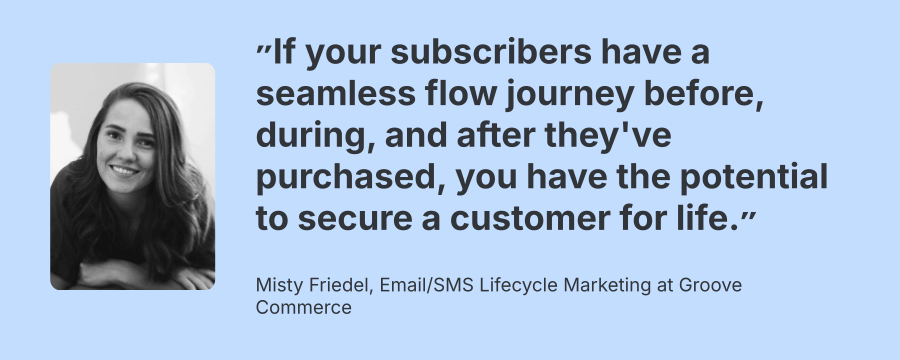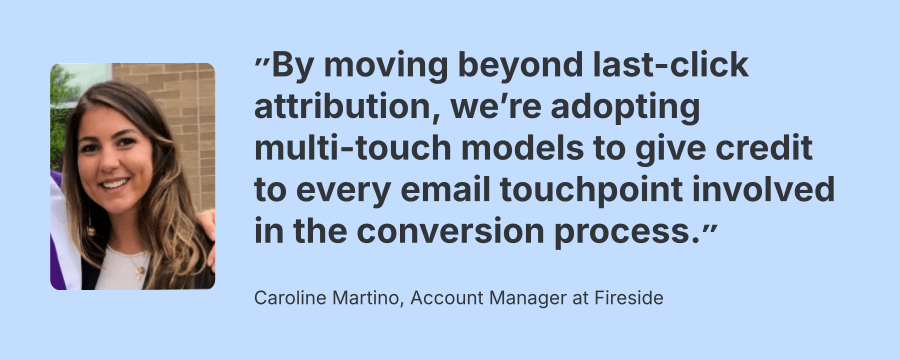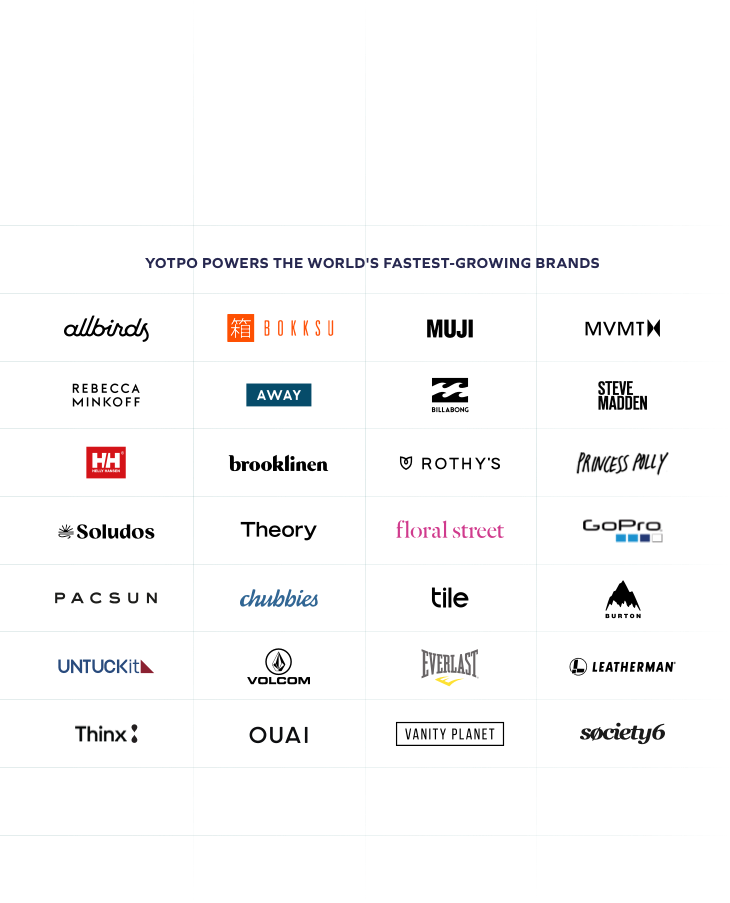AI Enhances But Doesn’t Replace Human Creativity
When it comes to the future of email and SMS marketing, will AI be a total game-changer or more of a supporting act? Let’s see what our experts think.
AI as Assistant: Provides Tools and Insights but Requires Significant Human Input
In its most basic role, AI serves as a capable sidekick, offering tools and insights that amplify human skills but still require significant human input. Tarren Jessop sees AI as “most helpful in streamlining strategy and in data analysis” – but not in the creative process. As she puts it, “I personally do not feel it belongs in the creative aspects of marketing!”
Rachel Hansen echoes this sentiment, believing that “AI will continue to be a supporting player” – a tool in the belt, but not a replacement for human ingenuity. “We’ve seen the amazing things AI can do, and also the instances when AI absolutely botches the task,” she notes. The key is finding the right balance. She also reveals how strategic technological insights can transform email send times, with AI helping identify that late evening is the optimal time for engaging their audience of older women and moms.
AI as Collaborator: Actively Participates in the Creative Process, Suggesting Ideas and Making Decisions
For some, AI plays a more active role — not just a tool but a true collaborator. At this level, AI participates in creative processes, suggesting ideas and enabling new levels of personalization and optimization. Pam Medina Juan has seen firsthand how “AI has significantly changed the email marketing landscape” – from suggesting subject lines to defining segments and creating copy. “This gives me a highly inspired, data-driven approach to my email creation and scheduling process,” she explains.

Here, AI goes beyond simply supporting marketing efforts. It actively shapes strategy, co-creating with marketers to create more tailored customer experiences. Caroline Martino envisions a future where AI doesn’t just assist but transforms how we connect with customers. She believes AI’s “real strength lies in amplifying human creativity and efficiency” – and envisions how AI might get smarter in the future to do so. “Imagine campaigns that adjust on the fly based on user behavior—personalizing offers and content blocks at the moment, while predicting the best times to engage,” she muses. “At this point, AI could move beyond a supporting tool to become an essential partner in driving retention strategies and creating meaningful customer experiences.”

AI as Co-Pilot: Automates Routine Tasks, Freeing up Human Time for More Strategic Work
At its most autonomous, AI operates as a hands-on partner, automating routine and repetitive tasks and freeing up marketers to focus on higher-level strategic work. Piper Martz is already using generative AI to “map out our email/SMS programming calendar for each month” and wants to take it further, tapping into AI to help build out first drafts of email and SMS copy that open up more opportunities for A/B testing subject lines and SMS sends.
Philip Sblendorio agrees, seeing AI as a future game-changer for “processes that are time-consuming and could be thoughtfully automated” – like copywriting, template optimization, and A/B testing.
AI can also support better engagement metrics and refine sender performance. By using predictive analytics to forecast open and click-through rates, AI can help marketers identify the optimal send times and audience segments, ultimately driving improved deliverability and engagement.

The Human Touch
But while the experts are excited about AI’s potential, they all underscore the continued importance of human involvement. As Caroline Martino points out, “the human touch remains crucial” – ensuring that AI-powered messaging stays “empathetic, authentic, and aligned with brand values.” She believes that “the future isn’t about replacing people but empowering them—allowing marketers to focus on strategy, creativity, and building relationships, while AI takes care of the heavy lifting.”
As Matthew sums it up, “Being able to send the right message, at the right time, to the right person has never been easier” thanks to AI. But the human element will always be essential, guiding the AI and ensuring the personal touch remains at the heart of every customer interaction.
Beyond Segments
Alex Greifeld offers a bold vision for the future: “AI will enable creative subscriber relevance in the same way that Meta’s ‘black box’ matches ads with audiences. The idea of CRM segmentation will be nearly obsolete in 5 years.” If CRM segmentation fades, we could be looking at a future where AI matches content to consumers, based on behaviors and interests rather than fixed categories—a shift that could reshape how marketers connect with audiences.
Lauren Del Vecchio envisions AI answering the complex questions of “delivering the right message to the right person at the right time.” AI’s impact goes beyond individual campaigns; it’s shaping entire strategies that prioritize what subscribers need and value most.
AI Goes Beyond Basic Personalization
Gone are the days when dropping a first name into an email subject line or text message counted as “personalization.” In 2025, AI is taking personalization to mind-bending new levels, and our experts are here for it.
Testing and Iteration
Remember when A/B testing meant manually creating different versions and waiting for results? Well, those days could be over. Piper Martz believes that AI will take out the manual work, declaring, “We 100% need to be leveraging AI to speed up and scale up our AB testing – for pop-ups, copy, content, and product recommendations.”
Pam Medina Juan is taking a similar approach, planning to use AI to create “multiple iterations of a single email” for testing different messaging, visuals, and subject lines.
Predicting Customer Behavior
Here’s where things get really interesting. Misty Friedel is using AI to peek into the future – well, sort of. She’s leveraging AI to predict “when a subscriber is going to churn, unsubscribe, or when they are likely to purchase again.” Talk about getting ahead of the game!

As Caroline Martino beautifully puts it, “AI will be the engine driving the next evolution of customer-centric marketing. It won’t just automate tasks—it will enable us to build deeper, trust-based relationships with our customers by anticipating their needs and delivering exactly what they want when they need it most.”
The Smart Shopping Assistant
Tarren Jessop is keeping it focused and practical, using AI primarily for “audience segmentation and to recommend products based on their browsing history.” Meanwhile, Caroline Martino sees AI diving deep into behavioral patterns, “identifying pain points across the customer journey” to proactively address issues through personalized messaging and offers.
The Time-Saving Game Changer
Philip Sblendorio is all about that efficient life, using AI to “move quickly and provide alternative content ideas.” But he adds an important caveat: when using GPT for copy, you need to “provide the tech with a thorough understanding of the brand, voice, and task.” In other words, AI needs context to create content that actually connects.
The Human Touch: Still Not Optional
While everyone’s excited about AI’s capabilities, there’s a clear consensus that human oversight isn’t going anywhere. Rachel Hansen keeps it real: “Very rarely do I take the AI’s response word-for-word, but it’s always a helpful tool to get a bit of help from.”
When it comes to SMS, though, the stakes are even higher. An AI-generated copy can come off as generic or even spammy—enough to make customers consider unsubscribing. As Matthew Fier points out, “Until we can marry a brand’s authentic voice into the content, we don’t want to ‘fool’ our customers.” Respect for authenticity wins every time!
Unified Attribution Requires Tools and Analysis
Today, customers move seamlessly between email, SMS, social media, website visits, and a slew of other touchpoints – making it increasingly challenging to pinpoint exactly where those conversions are coming from. But the brands that will come out on top are the ones who get savvy about attribution, using a suite of tools and strategies to cut through the complexity and understand the true impact of their email and SMS marketing efforts.
Taking a Holistic Approach to Measurement
“Unified Analytics” is the name of the game, according to Pam Medina Juan. “I’m using integrated analytics platforms that combine data from email, social media, and web traffic,” she explains. “This allows for a holistic view of how email campaigns contribute to overall marketing goals.”
It’s a sentiment echoed by Matthew Fier, who champions the use of third-party tools like GA4 and TripleWhale. “We track a lot of data – we have benchmarks in the platform but we also use other tools to make sure we’re getting as clear a picture as possible,” he shares.
Digging Deeper with UTM Parameters and Customer Journey Mapping
But data alone isn’t enough. As Caroline Martino points out, “With varying attribution models across platforms, we consistently use UTM tagging in email links to track specific content and sources within our campaigns.”

Pam Medina Juan takes it a step further, diving deep into customer journey mapping. “I’m mapping out the customer journey to understand how email interacts with other touchpoints,” she explains. “This helps identify the role of email in driving conversions and engagement.”
Putting the Pieces Together Through Collaboration and Testing
Of course, all the data in the world means nothing if you can’t put it into action. That’s why Philip Sblendorio advocates for getting his team’s “sleeves rolled up” to collaborate with other marketing departments and “draw the full picture.”
And for Alex Greiffeld it’s all about the power of holdout testing. “I’m running holdout tests on any audience-specific promos/incentives and tracking the cohort repeat rates & LTV of subscribers vs non-subscribers,” she shares.
Identity Resolution Unifies the Customer Experience
We call it the challenge of the fragmented customer journey. Consumers move seamlessly between devices and platforms, leaving marketers with the challenge of piecing together a cohesive understanding of their identity and behaviors.
Caroline Martino explains her team is using a variety of identity resolution tools to deanonymize traffic and maintain consistent customer profiles across platforms. And she’s not alone in this sentiment – identity resolution has become a critical piece of the puzzle for brands looking to deliver truly personalized, connected experiences.
And for the marketers who get it right, the payoff will be substantial – deeper customer insights, more personalized engagement, and ultimately, stronger, more valuable relationships that stand the test of time.
Unifying Data from Multiple Sources
So how are forward-thinking marketers tackling this challenge? According to Caroline Martino, the key lies in “integrating multiple solutions—such as customer data platforms, CRM systems, and third-party identity resolution services.”
By bringing together data from these diverse sources, brands can effectively match and unify customer data from various touchpoints. It’s a strategy that allows them to paint a complete picture of each individual’s journey, no matter how fragmented it may appear on the surface.
Leaning on Specialized Tools and Partners
Of course, executing this type of comprehensive identity resolution isn’t always easy. That’s why Philip Sblendorio, points to a suite of specialized tools and services that can help, including Elevar, Black Crow, Opensend, and Retention.
The message is clear: when it comes to cracking the code of identity resolution, brands can’t go it alone. They need to be willing to invest in the right technologies and partnerships to get the job done.
Keeping the Customer Experience at the Forefront
But identity resolution isn’t just about the data – it’s about the customer experience. As Andrew Windle points out, the key is to strive for a “logged-in experience cross-device when possible.”
By maintaining that consistent, personalized touch across all of a customer’s interactions, brands can ensure that the experience feels seamless and tailored, no matter where they’re engaging. It’s a strategy that not only delights customers but also lays the groundwork for stronger, more valuable long-term relationships.



































 Join a free demo, personalized to fit your needs
Join a free demo, personalized to fit your needs